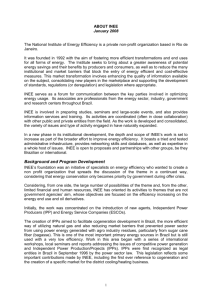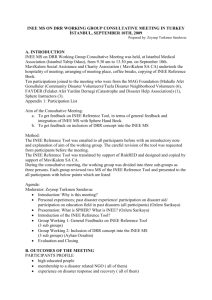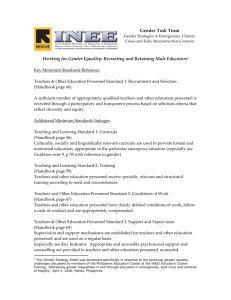Advocacy brief: The INEE Minimum standards and
advertisement
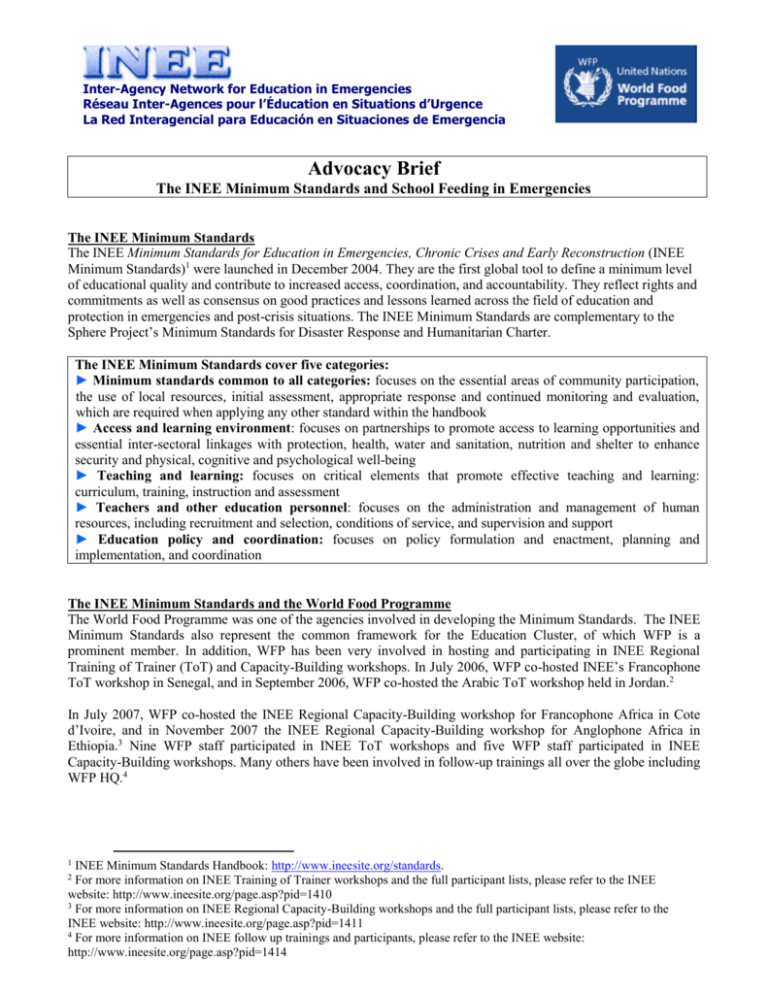
Inter-Agency Network for Education in Emergencies Réseau Inter-Agences pour l’Éducation en Situations d’Urgence La Red Interagencial para Educación en Situaciones de Emergencia Advocacy Brief The INEE Minimum Standards and School Feeding in Emergencies The INEE Minimum Standards The INEE Minimum Standards for Education in Emergencies, Chronic Crises and Early Reconstruction (INEE Minimum Standards)1 were launched in December 2004. They are the first global tool to define a minimum level of educational quality and contribute to increased access, coordination, and accountability. They reflect rights and commitments as well as consensus on good practices and lessons learned across the field of education and protection in emergencies and post-crisis situations. The INEE Minimum Standards are complementary to the Sphere Project’s Minimum Standards for Disaster Response and Humanitarian Charter. The INEE Minimum Standards cover five categories: ► Minimum standards common to all categories: focuses on the essential areas of community participation, the use of local resources, initial assessment, appropriate response and continued monitoring and evaluation, which are required when applying any other standard within the handbook ► Access and learning environment: focuses on partnerships to promote access to learning opportunities and essential inter-sectoral linkages with protection, health, water and sanitation, nutrition and shelter to enhance security and physical, cognitive and psychological well-being ► Teaching and learning: focuses on critical elements that promote effective teaching and learning: curriculum, training, instruction and assessment ► Teachers and other education personnel: focuses on the administration and management of human resources, including recruitment and selection, conditions of service, and supervision and support ► Education policy and coordination: focuses on policy formulation and enactment, planning and implementation, and coordination The INEE Minimum Standards and the World Food Programme The World Food Programme was one of the agencies involved in developing the Minimum Standards. The INEE Minimum Standards also represent the common framework for the Education Cluster, of which WFP is a prominent member. In addition, WFP has been very involved in hosting and participating in INEE Regional Training of Trainer (ToT) and Capacity-Building workshops. In July 2006, WFP co-hosted INEE’s Francophone ToT workshop in Senegal, and in September 2006, WFP co-hosted the Arabic ToT workshop held in Jordan.2 In July 2007, WFP co-hosted the INEE Regional Capacity-Building workshop for Francophone Africa in Cote d’Ivoire, and in November 2007 the INEE Regional Capacity-Building workshop for Anglophone Africa in Ethiopia.3 Nine WFP staff participated in INEE ToT workshops and five WFP staff participated in INEE Capacity-Building workshops. Many others have been involved in follow-up trainings all over the globe including WFP HQ.4 1 INEE Minimum Standards Handbook: http://www.ineesite.org/standards. For more information on INEE Training of Trainer workshops and the full participant lists, please refer to the INEE website: http://www.ineesite.org/page.asp?pid=1410 3 For more information on INEE Regional Capacity-Building workshops and the full participant lists, please refer to the INEE website: http://www.ineesite.org/page.asp?pid=1411 4 For more information on INEE follow up trainings and participants, please refer to the INEE website: http://www.ineesite.org/page.asp?pid=1414 2 Why are the INEE Minimum Standards relevant for School Feeding? In recent years, the use of school feeding in emergencies has become a common education intervention around the world. A number of organizations implementing school feeding programs are using the INEE Minimum Standards for programming and policy purposes. The INEE Minimum Standards are referenced in WFP’s Thematic Evaluation of School Feeding in Emergency Situations (2007) and will be included in WFP’s Policy Paper on School Feeding. The INEE Minimum Standards have also been applied by WFP to school feeding in various countries including Mali, Liberia and Uganda. The INEE Minimum Standards are being used to enhance the quality of school feeding programming through areas such as community participation, education access and relevance, and coordination. As a common framework for the education community, the INEE Minimum Standards can be used to reinforce strong linkages between school feeding and wider education programmes. 5 In addition, since the indicators for the INEE Minimum Standards are intended to be contextualized to local situations, they are relevant for school feeding programmes in a variety of situations from acute emergency, to chronic crisis, to post-conflict or post-disaster recovery. Finally, the standards represent an instrumental tool for bridging the gaps between disaster risk reduction, humanitarian response, and development, and provide effective support for sustainable programming throughout this continuum. In the development of the standards, care has been taken to incorporate several important cross-cutting issues. These relate to human and children’s rights, gender, the right of populations to participate, HIV/AIDS, disability and vulnerability. Therefore, using the INEE Minimum Standards ensures that these cross-cutting issues are adequately addressed with school feeding and education programmes. How can the standards be applied to School feeding? There are specific standards, including a set of indicators and guidance notes for each, that directly relate to school feeding programming, particularly the standards on: 1. Access and Learning Environment Standard 1:Equal Access All individuals have access to quality and relevant education opportunities. Standard 2: Protection and Well-Being Learning Environments are secure, and promote the protection and mental and emotional well-being of learners. (Also see Appendix 2: School Feeding Programme Checklist: This checklist provides important questions to ask if food is being considered as a resource for education interventions 6) 2. Community Participation Standard 1: Participation This Standard ensures that emergency-affected community members actively participate in assessing, planning, implementing, monitoring and evaluating the education programme. Standard 2: Resources Local resources are identified, mobilized and used to implement education programmes and other learning activities. 3. Assessment and Program Design Standard 1: Initial assessment An assessment of the emergency situation is conducted in a holistic and participatory manner. (Also see Appendix 2 which provides a Situation Analysis Checklist to identify the relevant factors, issues, people and institutions and Appendix 3 which provides an Information Gathering and Needs Assessment Questionnaire7) Standard 2: Response Strategy 5 INEE Minimum Standards Handbook, Access and Learning Environment Appendix 2: School Feeding Checklist: http://www.exacteditions.com/exact/browse/436/494/2635/3/51/0/School%20Feeding. 6 INEE Minimum Standards Handbook, Minimum Standards Common to All Categories- Appendix 2: Planning in an Emergency: Situation Analysis Checklist: http://www.exacteditions.com/exact/browse/436/494/2635/3/30/0/Situation%20Analysis 7 INEE Minimum Standards Handbook, Minimum Standards Common to All Categories-Appendix 3: Information Gathering and Needs Assessment Questionnaire. http://www.exacteditions.com/exact/browse/436/494/2635/3/33?dps A framework for an education response is developed, including a clear description of the problem and a documented strategy for action. (Appendix 2 provides a checklist for identifying key stakeholders, their responsibilities and capacities) 4. Monitoring and Evaluation Standard 3: Monitoring All relevant stakeholders regularly monitor the activities of the education response and the evolving education needs of the affected population. Standard 4: Evaluation There is a systematic and impartial evaluation of the education response in order to improve practice and enhance accountability. 5. Inter-Agency Coordination Standard 3: Coordination (Education policy and coordination) There is a transparent coordination mechanism for emergency education activities, including effective information sharing between stakeholders. How have the INEE Minimum Standards been used by WFP staff – Examples for School Feeding Uganda “The School Feeding (FFE) operation implemented by WFP in northern Uganda used the INEE Minimum Standards for programme assessment, planning, implementation, monitoring and evaluation. Using the INEE Minimum Standards, WFP was able to encourage participation of all stakeholders throughout the project cycle, ensuring that proper response plans were in place, that joint monitoring was carried out by the district activity monitoring committee (DAMC), and to check statistics in schools to monitor access, enrolment, attendance, and drop-out rates. They were also used to address issues related to classroom and education facilities, protection, community support, and to collaborate in order to identify solutions. We also used the standards in the consolidated appeal process (CAP) to develop goals, objectives, strategies and activities for fundraising for education intervention.” - Josephine Ojera, National Programme Officer, WFP Uganda Mali The INEE Minimum Standards have served both as an analytical tool and as a checklist for WFP’s work in Mali. WFP Mali has specifically used the standards on Community Participation, Initial Assessment, Evaluation, Equal Access and Protection and Well-being. These standards have facilitated WFP’s work conducting rapid assessments of target group capacities and existing local resources, providing access to formal and non-formal education without discrimination based on school fees or teaching language, ensuring that documents are not always necessary for children to enroll in school and promoting inter-agency coordination and action. Lessons learnt in this process include the importance of analyzing the situation, the need to understand how the community has been affected, and that community involvement is crucial for programme design and mobilizing local resources to support educational programmes. -Fatimata Sow-Sidibe, WFP Mali Education in Emergencies and the INEE Minimum Standards Education in Emergencies as a Form of Protection Education in emergencies is a necessity that can be both life-sustaining and life-saving, providing physical, psychosocial and cognitive protection. Education sustains life by offering structure, stability and hope for the future during a time of crisis, particularly for children and adolescents, and provides essential building blocks for future economic stability. It also helps to heal bad experiences and build skills, and supports conflict resolution and peace-building. Education in emergencies saves lives by directly protecting against exploitation and harm, and by disseminating key survival messages, such as landmine safety or HIV/AIDS prevention. The Inter-Agency Network for Education in Emergencies (INEE) is an open, global network of UN agencies, NGOs, donors, practitioners, researchers and individuals who work together within a humanitarian and development framework to ensure the right to quality education in emergencies, chronic crises and post-crisis reconstruction phases. The INEE Minimum Standards and Global Implementation In order to promote education as a key pillar of emergency response as well as develop a tool to help achieve a minimum level of quality and access to education, INEE facilitated a global consultative process in 2003 and 2004 involving over 2,250 individuals from more than 50 countries to develop global education standards. Minimum standards were developed, debated and agreed upon through a participatory process in which several WFP staff from all regions took part.8 Since their launch, the INEE Minimum Standards have been translated into twelve languages (Spanish, French, Arabic, Dari, Japanese, Bahasa Indonesian, Portuguese, Bangla, Thai, Urdu, Khmer) and are being used in more than 80 countries worldwide for programme and policy planning, assessment, design, implementation, monitoring and evaluation as well as for advocacy and preparedness purposes. Users relate that the INEE Minimum Standards provide a common language, serving as a framework for the development of shared visions between stakeholders, including members of affected communities, humanitarian agency staff and governments. They are being used as a training and capacity-building and more than 200 education, protection and emergency trainers have been trained on the INEE Minimum Standards, and are training hundreds of others through a cascade training model. The INEE Minimum Standards promote holistic thinking and response and are being used to frame and foster inter- and intra-agency policy dialogue, coordination, advocacy and action for the provision of quality education in emergencies, chronic crises and early reconstruction. Key Resources ● INEE Minimum Standards Handbook: http://www.ineesite.org/standards This handbook is the first global tool to define a minimum level of quality and access for education in emergencies. ● INEE Good Practice Guide: School Feeding: http://www.ineesite.org/uploads/documents/store/doc_1_School_Feeding.pdf This Guide provides a list of strategies, a checklist and useful resources for School Feeding. ● INEE Minimum Standards Handbook, Access and Learning Environment Appendix 2: School Feeding Checklist: http://www.exacteditions.com/exact/browse/436/494/2635/3/51/0/School%20Feeding This Checklist provides a list of important questions to be asked if food is being considered as a resource for education intervention. ● INEE Minimum Standards Toolkit: www.ineesite.org/toolkit The Toolkit contains the INEE Minimum Standards handbook, training and promotional materials, including all translations, as well as clear, practical tools and resources (including on cross-cutting issues such as human and children’s rights, gender, HIV/AIDS and disability) to help field staff and Ministry of Education officials implement the standards. ● HIV/AIDS and INEE Minimum Standards Matrix: http://www.ineesite.org/toolkit/docs/HIV_AIDS_tool_jso.pdf This Matrix links the Inter-Agency Standing Committee Guidelines for HIV/AIDS interventions to the corresponding INEE Minimum Standards, including indicators, across the sectors of coordination; assessment and monitoring; protection; water and sanitation; food security and nutrition; shelter and site planning; education; behavior change; communication and information education communication; and HIV/AIDS in the workplace. WFP: Contact Annmarie Isler: Annmarie.Isler@wfp.org INEE: Contact Jennifer Hofmann, INEE Coordinator for Minimum Standards: minimumstandards@ineesite.org 8 For a list of participants, please refer to the INEE Minimum Standards Handbook pages 91-94. http://www.exacteditions.com/exact/browsePages.do?issue=2635&size=2&pageLabel=91.
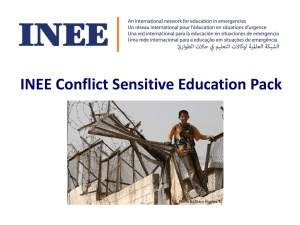
![View DRR Presentation Day 2 [PPT 774.00 KB]](http://s2.studylib.net/store/data/005450963_1-d9a539224e4e88c2b7c6d22d8b201673-300x300.png)
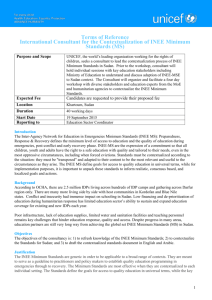
![View DRR Presentation Day 1 [PPT 1.07 MB]](http://s2.studylib.net/store/data/005562166_1-09058b36ec0804e4de33b95a0df46bfd-300x300.png)
